Blue lily is a name that instantly evokes elegance, but this stunning plant is more than just a pretty face. Also known as Agapanthus or Lily of the Nile, this drought-tolerant perennial is a favorite among gardeners for its tall stems, globe-shaped flower clusters, and ability to thrive with minimal attention. Native to South Africa, the blue lily adds structure, color, and texture to borders, containers, or mass plantings.
With blooms that range from vivid blue to white, and a variety of types suitable for both cold and warm zones, this plant offers flexibility and style. In this guide, you’ll learn how to choose, plant, and care for blue lily with ease — from sunlight and soil needs to overwintering and propagation tips.
Table of Contents
What Is a Blue Lily?
Despite the name, the blue lily isn’t technically a lily. It belongs to the Agapanthus genus and is native to South Africa, where it thrives in sun-soaked meadows and rocky slopes. Often referred to as the Lily of the Nile, the blue lily has become a staple in ornamental gardens thanks to its showy flowers and ease of care.
🌸 Key Characteristics:
- Flowers: Large, round clusters of funnel-shaped blooms that come in shades of blue, violet, or white. Each bloom cluster can hold up to 100 flowers.
- Foliage: Strap-like, glossy green leaves that form a dense, clumping base. The foliage adds texture even when the plant is not in bloom.
- Height: Mature plants typically grow 1 to 3 feet tall, with flower stalks sometimes extending even higher.
- Shape: Compact and bushy at the base, with upright, slender stems topped by bold floral displays.
While it carries a tropical air, the blue lily is surprisingly adaptable — thriving in containers, borders, and even urban patios. Its elegant structure and long blooming season make it an excellent choice for gardeners who want visual impact with minimal effort.
Where and When to Plant Blue Lily
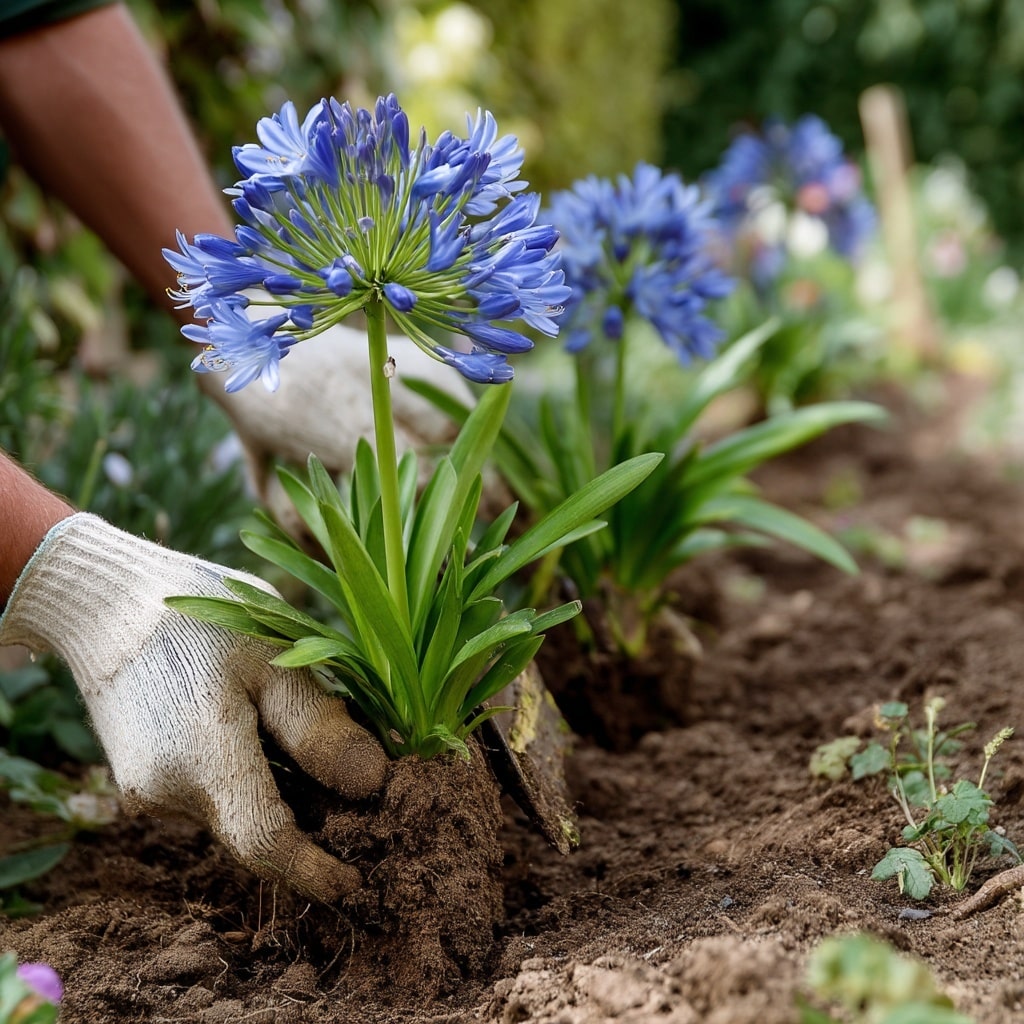
To get the most from your blue lily, location and timing matter. These sun-loving perennials are best planted in spring, after the last frost, so they can establish strong roots before blooming in summer.
☀️ Light Requirements
Blue lilies thrive in full sun. Aim for at least 6 hours of direct sunlight per day. While they can tolerate partial shade, too much shade may reduce flowering.
🌱 Soil Preferences
Well-draining soil is essential. A loamy mix that retains some moisture but doesn’t stay soggy will help prevent root rot. If planting in containers, use a loam-based potting mix for best results.
Container or Ground?
- Containers: Great for colder climates or small spaces. Blue lily blooms more profusely when slightly root-bound, making pots an ideal choice.
- Garden Beds: Ideal for warmer zones (USDA Zones 7–11). In borders, space plants based on their mature width — typically 12–18 inches apart.
📅 Planting Timeline
- Spring: Best time to plant rhizomes or young plants
- Summer: Expect blooms from mid to late summer
- Fall: In colder zones, dig up or protect outdoor plants before frost
By choosing the right spot and soil, you’ll give your blue lily a strong start — and set the stage for vibrant blooms all season long.
How to Grow and Care for Blue Lily

Once established, blue lily is remarkably low-maintenance — making it ideal for both beginner and seasoned gardeners. A few simple practices will keep it blooming beautifully year after year.
💧 Watering Needs
In its first growing season, water regularly to help roots settle. After that, blue lily becomes more drought-tolerant and only needs watering during dry spells. Be careful not to overwater — blue lily dislikes soggy soil.
☀️ Sunlight and Temperature
These plants love warmth. Provide at least 6 hours of sunlight daily for strong blooms. In cooler climates, they can tolerate light frost but may need winter protection or container relocation.
🌿 Feeding Schedule
Fertilize twice a year — once in spring and again in midsummer — with a balanced or high-potassium fertilizer. Avoid overfeeding, which can lead to excessive leaf growth and fewer flowers.
General Maintenance Tips:
- Deadhead spent blooms to encourage continued flowering
- Remove yellowing or damaged leaves to keep the plant tidy
- Cut back flower stalks once the blooming cycle ends
- Mulch lightly around in-ground plants to retain moisture and suppress weeds
With minimal effort, the blue lily will reward you with bold, colorful blooms and graceful foliage. Its natural resilience and tidy form make it a favorite in both urban gardens and expansive landscapes.
Seasonal Care: Deadheading, Overwintering & Dividing

Caring for blue lily through the seasons ensures healthier growth and stronger blooms year after year. From trimming to winter prep, a little seasonal attention goes a long way.
✂️ Deadheading and Cleanup
Remove faded flower stalks by cutting them at the base once blooming ends. This helps the plant conserve energy and may encourage a second flush of flowers. Leave the foliage in place after blooming — it continues photosynthesis and supports root health.
Clear away any dead or damaged leaves throughout the year. For deciduous varieties, clean up dying foliage in late fall.
Overwintering Tips
Blue lily is hardy in USDA Zones 7–11, but cold-sensitive varieties may need winter protection:
- In containers: Move pots to a frost-free garage or greenhouse before the first frost.
- In-ground plants: Add a thick layer of mulch around the base in late fall to insulate roots.
- Evergreen types: Protect with horticultural fleece or bring indoors if temps drop below freezing.
Avoid overwatering during dormancy. Allow soil to dry slightly between waterings.
Dividing for Better Blooms
Every 4 to 5 years, divide crowded plants to rejuvenate them and improve flowering. Use a clean, sharp knife to separate the rhizomes, ensuring each division has roots and at least one growing point.
- Divide evergreen varieties after flowering
- Divide deciduous varieties in early spring before new growth appears
Replant divisions in fresh soil and give them time — most won’t bloom until the following season.
Blue Lily Varieties You’ll Love
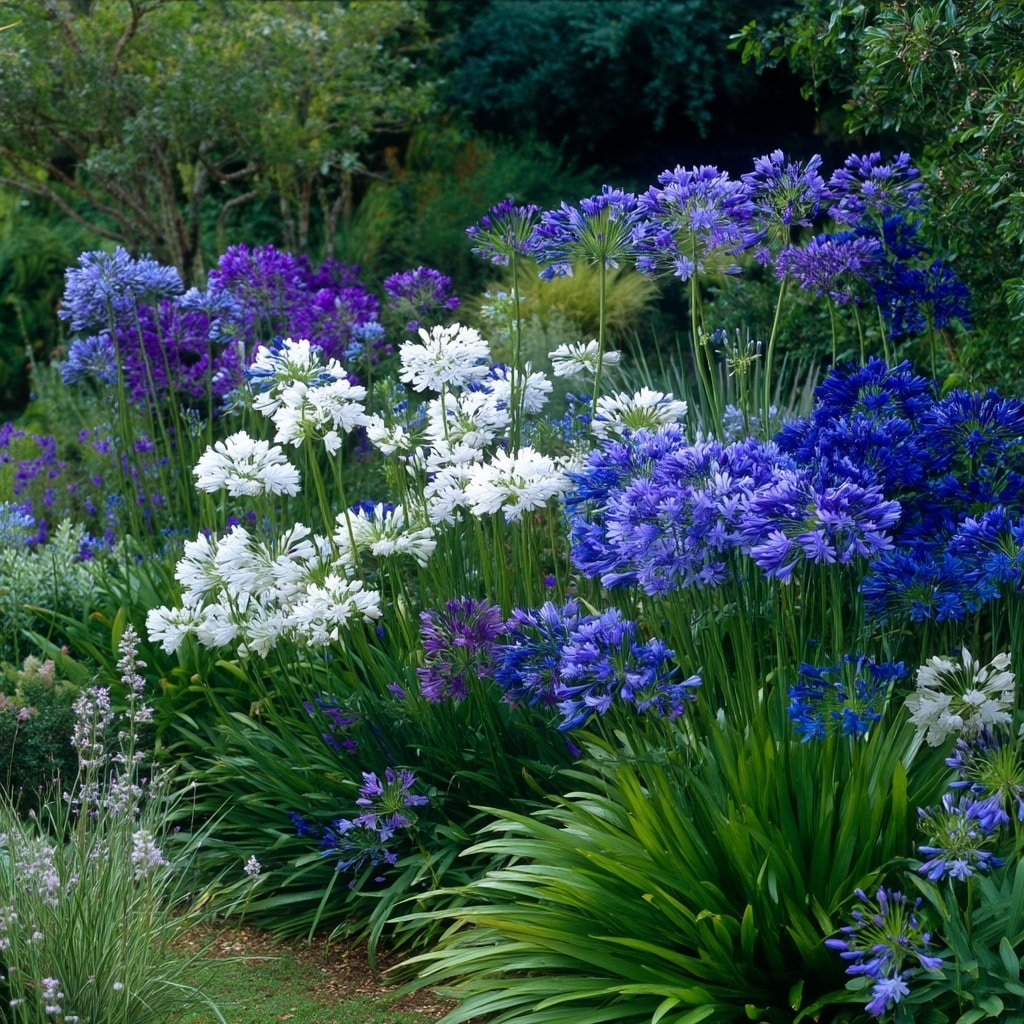
With hundreds of hybrids and cultivars available, choosing the right blue lily can add just the right color, size, and form to your garden. Some are compact and container-friendly, while others stretch tall with dramatic flower heads. Below are a few standout varieties to consider.
Popular Evergreen Blue Lily Varieties:
- Agapanthus africanus ‘Peter Pan’
Compact (12–24 inches tall) with soft blue flowers. Ideal for borders and small containers. - Agapanthus ‘Ever Sapphire’
Deep sapphire-blue flowers on short stems. Blooms earlier than many other types. - Agapanthus africanus ‘Albus’
Elegant white-flowered variety with the same easy-care nature. Striking in mixed color gardens.
Notable Deciduous Blue Lily Varieties:
- Agapanthus praecox ‘Flore Pleno’
Rare double-flowered cultivar with rich lavender-blue petals. Grows 2–3 feet tall. - Agapanthus ‘Queen Anne’
Dwarf plant (12–24 inches) with sky-blue blooms. Great for edging and pots. - Agapanthus ‘Snowball’
Compact white-flowered cultivar with clean, rounded flower heads.
Evergreen vs. Deciduous: What’s the Difference?
- Evergreen types retain their foliage year-round and require more frost protection.
- Deciduous types go dormant in winter and are better suited for cooler zones.
If you’re short on space, look for dwarf cultivars bred specifically for containers. Many varieties flower best when slightly pot-bound, so don’t rush to upsize your container.
Harvesting Blooms and Saving Seeds
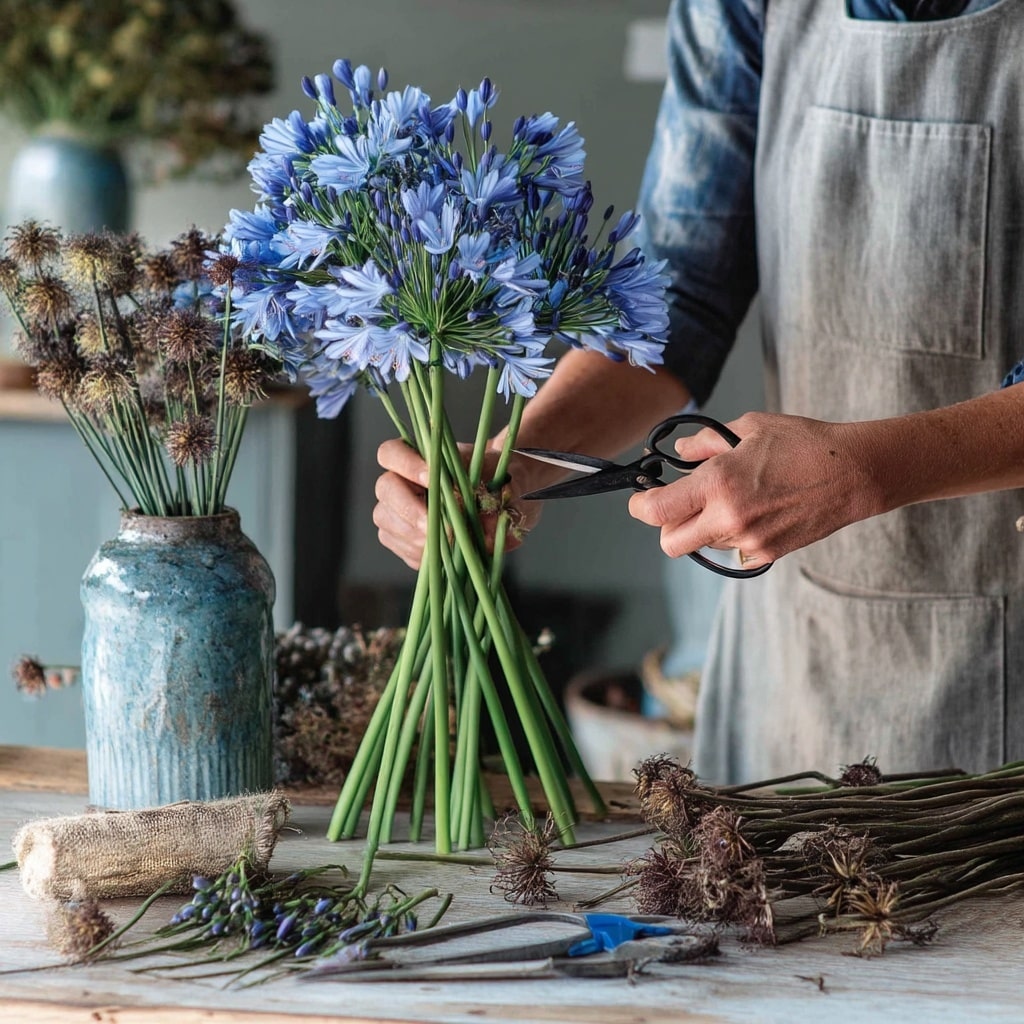
One of the most rewarding parts of growing blue lily is enjoying its long-lasting blooms — both in the garden and in a vase. Whether you’re snipping stems for bouquets or gathering seeds for future plants, timing and technique matter.
Cutting Blooms for Arrangements
Blue lily flowers make stunning cut flowers, often lasting up to 10 days in a vase with proper care.
How to Harvest Blooms:
- Wait until flowers are fully open for best vase life
- Use clean, sharp scissors or pruners
- Cut the stalk low on the stem, just above the foliage
- Remove lower leaves that would sit in water
Place the stems in cool water immediately and keep them out of direct sunlight indoors to extend freshness.
Collecting and Growing from Seed
While division is the faster way to multiply blue lily plants, seed saving can be rewarding if you’re patient.
Steps to Collect Seeds:
- Allow flowers to fully dry on the stalk
- Collect seed pods when they turn brown and papery
- Crack open pods and remove black seeds
- Store seeds in a cool, dry place until spring planting
Sow seeds ¼ inch deep in potting mix in spring. Germination may take several weeks, and seed-grown plants may take 2–5 years to flower. Each seedling is genetically unique — a fun surprise for patient gardeners.
Common Issues and Flowering Problems
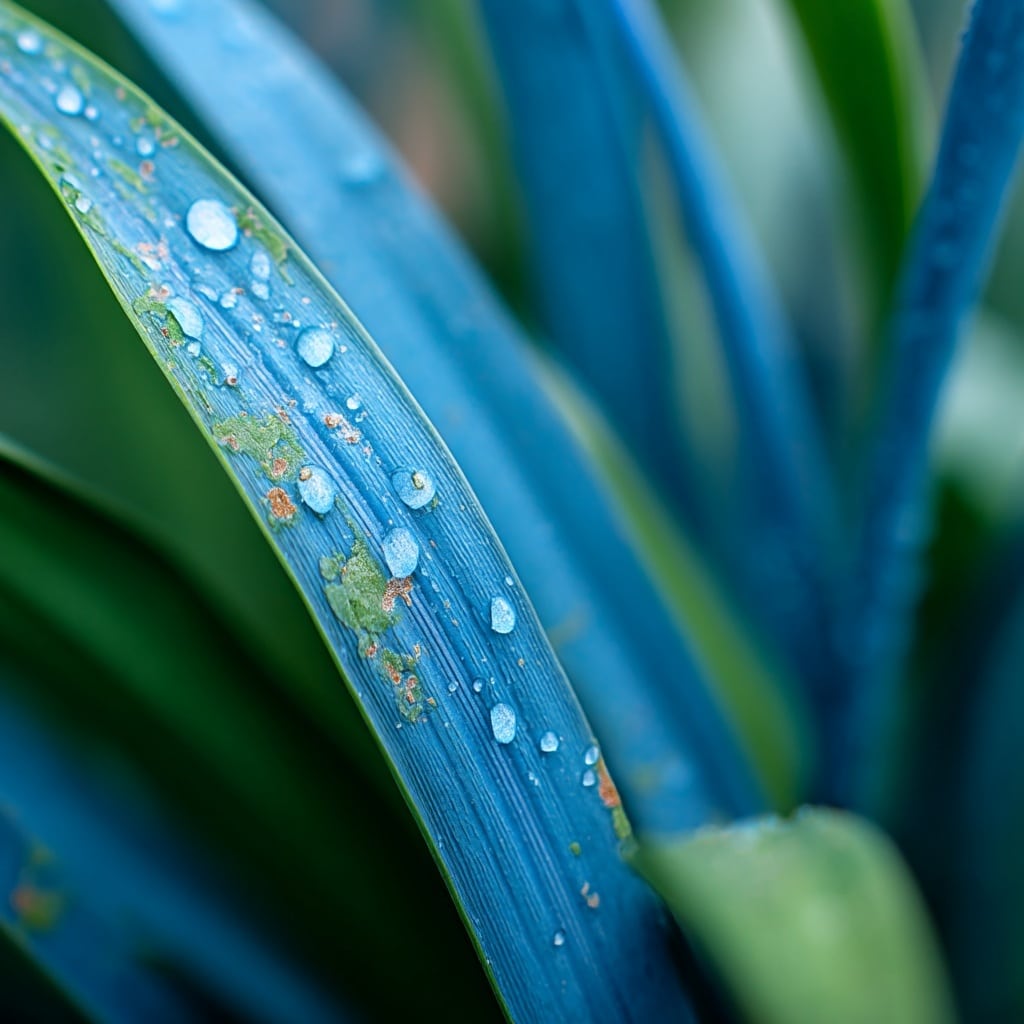
While blue lily is generally easy to grow, it can sometimes face pests, diseases, or disappointing bloom performance. The good news? Most issues are preventable with a bit of awareness and routine care.
Pests to Watch For:
- Mealybugs: Look for white, cottony clumps on stems or leaves
- Slugs & Snails: These pests chew holes in leaves, especially in damp areas
- Spider Mites: Fine webbing and stippling on foliage are signs
- Thrips: Tiny insects that distort flowers and suck sap from leaves
🛠️ Solution: Remove pests by hand or with a strong water spray. For infestations, use neem oil or insecticidal soap.
Diseases That Affect Blue Lily:
- Botrytis blight (gray mold): Causes browning and moldy patches, especially in humid conditions
- Root rot: Often the result of overwatering or poor drainage
🛠️ Solution: Improve air circulation, remove infected plant parts, and avoid overhead watering. Use well-draining soil to prevent rot.
Why Isn’t My Blue Lily Flowering?
Common reasons include:
- Too much shade – Blue lily needs full sun for best blooms
- Over-fertilization – Too much nitrogen = more leaves, fewer flowers
- Crowded roots – If rootbound or not divided in years, blooming can suffer
- Lack of winter rest – Cold dormancy is essential for healthy flowering in some types
🛠️ Fix: Move plants to sunnier locations, use high-potassium fertilizer, and divide overcrowded clumps every 4–5 years.
Fun Facts, Safety Tips, and Final Thoughts
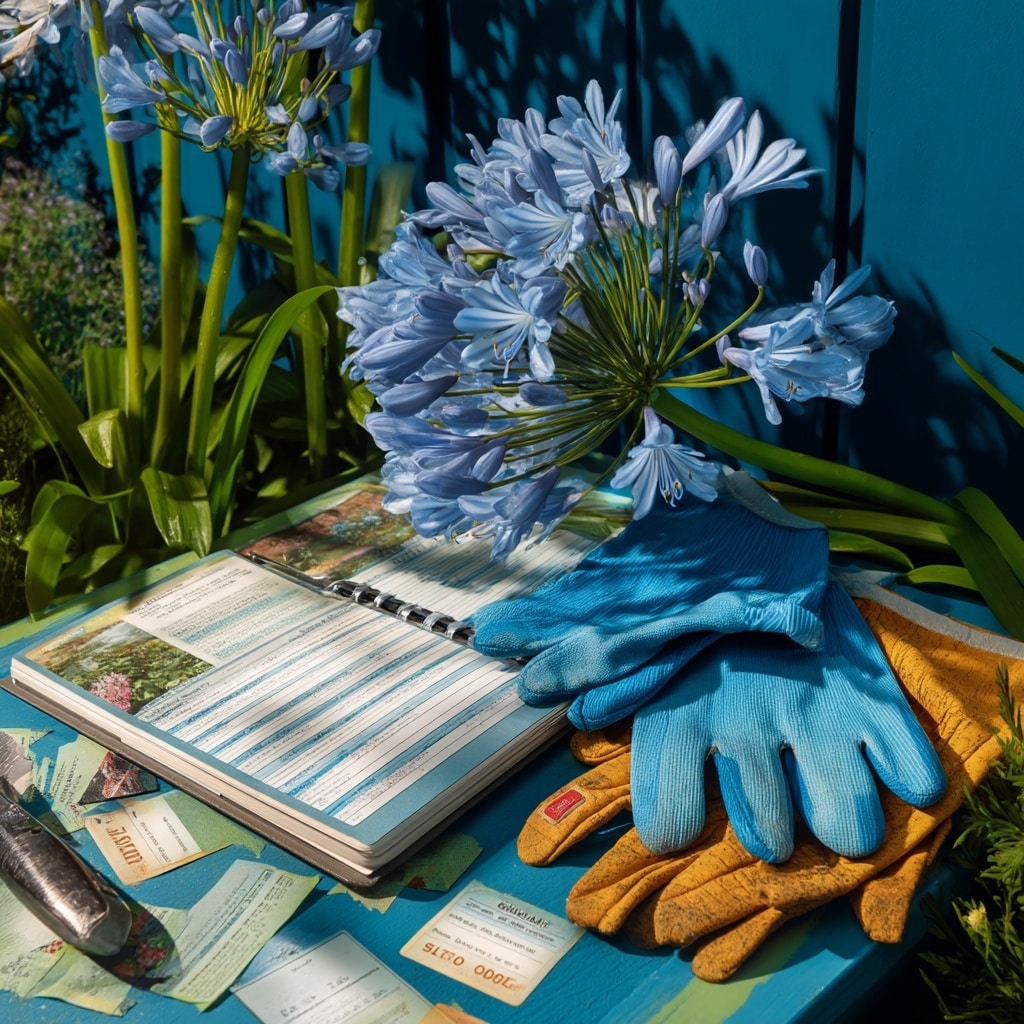
Beyond its bold appearance and easy care, the blue lily carries a fascinating history and a few things gardeners should keep in mind when handling or planting it.
Did You Know?
- The name Agapanthus comes from Greek: agape (love) + anthos (flower), giving it the nickname “flower of love.”
- Though often called the Lily of the Nile, blue lily actually hails from South Africa, not the Nile region.
- Some plants may unexpectedly produce white flowers — a rare, natural mutation.
- In traditional South African medicine, blue lily is used for ailments from coughs to heart issues. Its leaves are even applied as bandages.
Handle With Care
While beautiful, blue lily contains compounds that may irritate skin and should not be ingested. Its sap can cause mild dermatitis in sensitive individuals, and chewing any part of the plant may lead to mouth irritation in pets or children.
🛡️ Safety Tips:
- Wear gloves when dividing or pruning
- Keep plants out of reach of curious pets
- Wash hands after handling
Conclusion: Add Lasting Beauty with Blue Lily
Whether you’re a seasoned gardener or just starting out, the blue lily offers a perfect blend of elegance and ease. With its tall stems, vivid blue blooms, and ability to thrive in containers or borders, it’s a standout in any setting. By following a few simple planting and care tips — including proper sun exposure, watering, and seasonal maintenance — you’ll enjoy healthy plants that return year after year.
And with varieties suited to different climates, blue lily is more versatile than many think. Add it to your garden plan this season for structure, color, and long-lasting impact.




